#Food Delivery App Data Scraping
Explore tagged Tumblr posts
Text
Exploring the Uber Eats API: A Definitive Guide to Integration and Functionality
In this blog, we delve into the various types of data the Uber Eats API offers and demonstrate how they can be ingeniously harnessed to craft engaging and practical meal-serving apps.
#Uber Eats Data Scraping API#Scrape Uber Eats Data API#Extract Uber Eats Data#Scrape Food Delivery App Data#Food Delivery App Data Scraping
0 notes
Text
Exploring the Uber Eats API: A Definitive Guide to Integration and Functionality
In this blog, we delve into the various types of data the Uber Eats API offers and demonstrate how they can be ingeniously harnessed to craft engaging and practical meal-serving apps.
#Uber Eats Data Scraping API#Scrape Uber Eats Data API#Extract Uber Eats Data#Scrape Food Delivery App Data#Food Delivery App Data Scraping
0 notes
Text
Kroger Grocery Data Scraping | Kroger Grocery Data Extraction
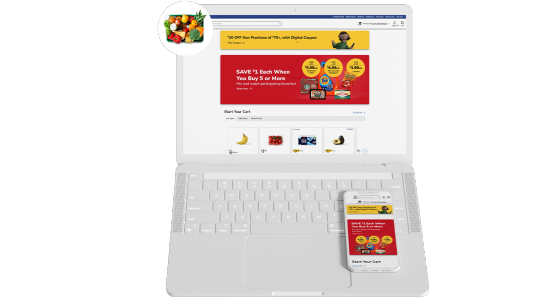
Shopping Kroger grocery online has become very common these days. At Foodspark, we scrape Kroger grocery apps data online with our Kroger grocery data scraping API as well as also convert data to appropriate informational patterns and statistics.
#food data scraping services#restaurantdataextraction#restaurant data scraping#web scraping services#grocerydatascraping#zomato api#fooddatascrapingservices#Scrape Kroger Grocery Data#Kroger Grocery Websites Apps#Kroger Grocery#Kroger Grocery data scraping company#Kroger Grocery Data#Extract Kroger Grocery Menu Data#Kroger grocery order data scraping services#Kroger Grocery Data Platforms#Kroger Grocery Apps#Mobile App Extraction of Kroger Grocery Delivery Platforms#Kroger Grocery delivery#Kroger grocery data delivery
2 notes
·
View notes
Text
Leverage Real-time Whataburger Menu Data Scraping 2025
Real-time Whataburger Menu Data Scraping 2025 delivers accurate regional pricing insights and menu intelligence for strategic decisions. Recognized for its orange-and-white A-frame buildings and customizable burgers, the brand now spans 16 states, primarily across the southern United States.
#Scrape Whataburger restaurant locations data in the USA#Whataburger Food Data Scraping Services#Extract Whataburger Food Delivery Data#Extract Whataburger prices and product details#Web Scraping Whataburger Restaurant Listings#Whataburger Restaurant App Datasets#Real-time Whataburger Menu Data Scraping
0 notes
Text
Realigning Food Delivery Market Moves with Precision Through Glovo Data Scraping

Introduction
This case study highlights how our Glovo Data Scraping solutions empowered clients to monitor food delivery market trends strategically, refine service positioning, and execute agile, data-backed business strategies. Leveraging advanced scraping methodologies, we delivered actionable market intelligence that helped optimize decision-making, elevate competitiveness, and drive profitability.
Our solutions offered a clear strategic edge by enabling end-to-end visibility into the delivery ecosystem to Extract Food Delivery Data. This comprehensive insight allowed clients to fine-tune service models, sharpen market alignment, and achieve consistent revenue growth through accurate competitor benchmarking in the fast-moving food delivery sector.
The Client
A mid-sized restaurant chain operating across 75+ locations with a rapidly expanding digital footprint reached us with a critical operational challenge. Although the brand enjoyed strong recognition, it faced a noticeable drop in customer engagement driven by gaps in delivery service efficiency. To address this, Glovo Data Scraping was identified as a strategic solution, as service inconsistencies directly impacted their revenue goals and competitive position.
With a broad menu and widespread delivery zones, the restaurant struggled to manage delivery logistics, especially during peak hours when quick shifts in demand required fast action. Their manual approach failed to support Real-Time Glovo Data Scraping, leading to missed revenue opportunities and weakening customer loyalty.
Recognizing the need to refine their delivery strategy, the management team saw that without proper visibility into Glovo’s delivery ecosystem, they lacked the insights necessary for efficient operations and practical customer experience management.
Key Challenges Faced by the Client
In their pursuit of stronger delivery market intelligence and a sharper competitive edge, the client faced several operational and strategic hurdles:
Market Insight Shortage
Limited insights into Glovo's platform and competitors made scraping Glovo Delivery Information difficult, preventing effective market analysis necessary for informed business decisions.
Slow Response Adaptation
Reliance on manual weekly evaluations slowed the restaurant chain's ability to act quickly. Without Glovo Delivery Data Extraction, adapting to real-time market changes became a challenge.
Demand Forecasting Gap
Traditional methods failed to account for real-time delivery data. The restaurant chain needed Glovo Product Data Extraction to predict demand and adjust services based on emerging trends accurately.
Manual Process Overload
Labor-intensive processes hindered efficient service decisions. By applying methods to Scrape Glovo For Product Availability And Pricing, the restaurant chain sought automation to optimize service delivery.
Service Consistency Issue
Inconsistent service quality across zones presented a problem. They required Mobile App Scraping Solutions to streamline operations and ensure consistent service delivery across all customer touchpoints.
Key Solutions for Addressing Client Challenges
We implemented cutting-edge solutions to the client's challenges, combining delivery intelligence with advanced analytics.
Delivery Optimization Engine
We built a centralized platform that leverages Real-Time Glovo Delivery Time Data Extraction to collect live data from various restaurants and delivery zones, enabling efficient decision-making.
Competitor Monitoring System
Our system, designed to Extract Restaurant Menus And Prices From Glovo, quickly identifies service gaps when competitors adjust, giving restaurant chains the edge to adapt promptly.
Dynamic Market Signals
By integrating multiple delivery signals, such as peak hours and weather, with Glovo Scraping For Restaurant Delivery Services, we created flexible models that adjust to market fluctuations.
Automated Service Recommender
Using Real-Time Glovo Data Scraping, we implemented an automated engine that generates service suggestions based on customer feedback and competitive positioning, reducing the need for manual input.
Strategic Adjustment Mechanism
Competitor promotions directly influence our service strategies by using tools to Extract Food Delivery Data, optimizing delivery times and fees while ensuring premium offerings remain profitable.
Cloud-Based Monitoring Hub
A robust Mobile App Scraping Solution enables managers to access and update delivery data remotely, facilitating continuous optimization and transforming strategy management into a dynamic process.
Key Insights Gained from Glovo Data Scraping
Service Elasticity Analysis Revealed delivery time sensitivity across different menu items, offering immediate operational optimization opportunities.
Competitive Positioning Patterns Provided insights into neighborhood-specific delivery differences, supporting targeted service improvements.
Pricing Cycle Optimization Illuminated optimal fee adjustment timing for different meal categories, aiding in more strategic revenue management.
Data-Driven Service Decisions Enabled the implementation of adaptive delivery models based on competitive positioning patterns.
Benefits of Glovo Data Scraping From Retail Scrape
Strategic Boost
By utilizing solutions to Scrape Glovo Delivery Information, the client improved delivery strategies, positioning their services for maximum value, enhancing market responsiveness to competitive shifts.
Loyalty Growth
Using competitor service insights, the client predicted market trends and strengthened customer retention, employing to Extract Glovo Product Data to stay ahead of shifts in demand.
Efficient Operations
The client minimized manual efforts by employing advanced Real-Time Glovo Delivery Time Data Extraction, driving faster decisions and better service while ensuring precise positioning and operational success.
Competitive Edge
With advanced techniques to Scrape Glovo For Product Availability And Pricing, the client gained critical insights into market trends, allowing for service adjustments that boosted profitability in competitive delivery sectors.

Retail Scrape's Glovo Data Scraping solutions revolutionized our approach to delivery market positioning. By gaining comprehensive access to Extract Food Delivery Data insights, we rapidly adjusted our strategy, refined our service models, and achieved a remarkable 37% increase in customer retention.
- Operations Director, Leading Multi-Location Restaurant Chain
Conclusion
Maintaining optimal delivery service positioning is crucial in today's competitive food delivery market. Glovo Data Scraping empowers businesses to monitor competitor services, make informed decisions, and improve market competitiveness.
Our customized solutions offer smooth delivery intelligence and actionable insights, allowing businesses to refine their competitive positioning. With in-depth expertise in Glovo Delivery Data Extraction, we equip businesses with the tools to unlock valuable insights for strategic growth.
Our specialists help evaluate market positioning, refine delivery strategies, and boost profit margins through Real-Time Glovo Data Scraping. Contact Retail Scrape today to minimize service inconsistencies, enhance market positioning, and drive long-term revenue with our advanced food delivery intelligence solutions.
Read more >>https://www.retailscrape.com/glovo-food-delivery-data-scraping-for-market-insights.php
officially published by https://www.retailscrape.com/.
#Glovo data scraping#Glovo delivery data extraction#Scrape Glovo delivery information#Real-time Glovo data scraping#Glovo product data extraction#Extract restaurant menus and prices from Glovo#Real-time Glovo delivery time data extraction#Scrape Glovo for product availability and pricing#Glovo scraping for restaurant delivery services#Extract Food Delivery Data#Mobile App Scraping solution
0 notes
Text
Food Delivery App Scraping Services | Extract Restaurant Menu Data
Elevate your food business with our Food Delivery App Scraping Services. We can extract restaurant menu data from the USA, UK, UAE, Canada, China, India, and Spain.
know more: https://www.mobileappscraping.com/food-delivery-app-scraping-services.php
#Food Delivery App Scraping Services#extracting data from food delivery app#Food Delivery Mobile App Data Scraping#Extract Restaurant Menu Data
1 note
·
View note
Text
🍔💸 #SameRestaurant. #SameDish. #Differentprices.

Confused about why food costs vary across Swiggy, Zomato, and Uber Eats? You're not alone.
At Actowiz Solutions, we help brands, aggregators, and restaurant chains scrape and compare real-time menu prices and offer data across major food delivery platforms.
🔍 Here’s what we reveal: ✅ Dish-to-dish price comparisons across apps ✅ Delivery charges & platform service fees ✅ Discount offers & loyalty program tracking ✅ Menu variation by city, region, or PIN code ✅ Customer sentiment linked to pricing behavior
💡 If you're managing a cloud kitchen, a food delivery app, or a restaurant chain—menu price intelligence can shape your entire revenue strategy.
📥 Ready to uncover hidden pricing gaps and smarter market opportunities?
👉 Explore the insights: https://www.actowizsolutions.com/restaurant-menu-price-comparison.php
#RestaurantMenuScraping#FoodDeliveryData#SwiggyVsZomato#uberEatsInsights#PricingIntelligence#MenuPriceTracking#DeliveryPlatformAnalytics#DynamicPricing#web scraping#data extraction#data scraping#data solutions
1 note
·
View note
Text
Just Eat vs Uber Eats: Pizza Price Showdown in London

Introduction
Pizza is one of the UK’s most ordered foods, and platforms like Just Eat and Uber Eats are central to Londoners’ takeaway habits. But with rising delivery costs, service charges, and inconsistent offers, which app gives better value when it comes to pizza?
In this case study, Actowiz Metrics scrapes and compares live pizza prices, delivery fees, restaurant ratings, and discounted offers from Just Eat and Uber Eats in London.
Objective

To determine:
Which platform offers lower total cost for similar pizza items
Which app has better delivery time + service charges
Which offers more consistent discounts or coupons
Consumer perception via ratings & reviews
What Actowiz Scraped

Sample Data Snapshot – July 10, 2025

Key Findings
1. Delivery Fees
Just Eat generally charges £1.00–£1.50, significantly lower than Uber Eats’s £2.99–£3.49 in central London.
2. Service Fees
Uber Eats charges slightly higher service fees per order (~£0.80–£1.00), while Just Eat averages at ~£0.70–£0.90.
3. Discounts & Offers
Uber Eats had more automated discount coupons (like “10% off” or flat £2 off)
Just Eat had fewer active coupons but had lower base delivery rates
4. Final Checkout Cost
Just Eat orders were £0.40–£1.10 cheaper on average, especially when Uber’s coupon wasn’t applied.
Aggregated Price Comparison (Avg. over 25 restaurants)

Location Scope
Scraping was done across:
Central London (Soho, Shoreditch, Camden, Kensington)
Peak hours (6 PM to 9 PM)
Both Android and Web versions
Use Cases
For Consumers:
Use Actowiz-powered browser extensions or WhatsApp bots to check which app is cheaper before ordering
For Food Brands:
Monitor platform-based pricing competitiveness
Map which aggregator offers better exposure for your pizza menu
For Aggregators:
Use competitor scraping to balance discount offerings and delivery fee structures
Powered by Actowiz Metrics
Actowiz offers:
Multi-platform price comparison (Uber, Just Eat, Deliveroo)
Daily scraping during peak hours
Coupon parsing & promo tracking
Food category segmentation (Pizza, Burgers, Biryani, etc.)
Real-time dashboards and price alerting APIs
Client Testimonial
“Actowiz helped us identify high-margin pizza SKUs across apps in London. We restructured promo campaigns and increased app conversion by 18%.”
– Head of Growth, London Pizza Chain
Conclusion
While Uber Eats offers better promo codes, Just Eat is more consistently cost-effective for pizza orders in London. For frequent pizza lovers, Actowiz Metrics can help determine the smarter platform daily—based on scraped live data.
Brands, aggregators, and even end consumers can gain from pizza pricing intelligence powered by actowiz. Learn More
#CouponParsingAndPromoTracking#CompetitorScraping#RealTimeDashboards#PizzaPricingIntelligence#JustEatVsUberEats#MultiPlatformPriceComparison
0 notes
Text

🚀 Fuel Smarter Food Delivery Strategies with Real-Time JustEat Data!
In the highly competitive world of online food delivery, data is your secret ingredient. ArcTechnoLabs offers JustEat Data Scraping Services that empower food tech companies, delivery apps, and market analysts to gain a competitive edge through actionable insights.
🔍 Key Takeaways:
Access real-time restaurant listings, menus, pricing & reviews
Monitor competitors across regions & categories
Identify trending dishes and consumer preferences
Automate data flows into your CRM or BI tools
100% compliant, scalable & customizable scraping infrastructure
📊 "Food businesses using live data scraping have seen a 25–40% boost in efficiency and profitability." 🔗 Explore More>>>>https://www.arctechnolabs.com/justeat-data-scraping-services.php 📩 Contact us:[email protected]
💡 Why It Matters: Whether you're launching a new food delivery app or scaling your marketplace, timely and structured data from JustEat helps you optimize pricing, promotions, and product offerings — all backed by data.
#arctechnolabs#advancewebscrapingservices#webscrapingservices#webscrapingecommercedata#technology#india#dataanalytics#datamanagement
0 notes
Text
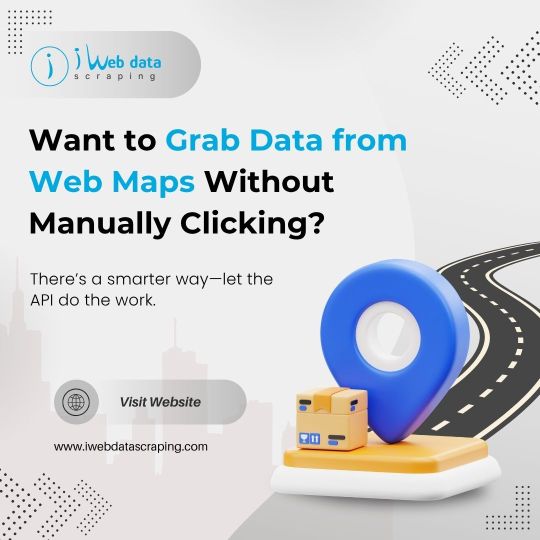
🚀 Want to extract hidden data from interactive web maps-without manual clicking?
Most web maps today are rich with valuable business data-but accessing it manually is slow, inefficient, and unscalable.
At iWeb Data Scraping, we solve this using smart #APIBasedExtraction. Instead of scraping visually, we go behind the map-using #RealTimeData endpoints for structured, clean, and #ScalableScraping
✅ Extract store locations, delivery zones, POIs
✅ Avoid manual clicks and visual blockers
✅ Pull data directly from the source
✅ Save time, scale effortlessly, and get cleaner datasets
🧠 How it works?
Inspect network calls
Identify the right API endpoint
Use scripts to extract data cleanly and automatically
💡 Whether it’s Google Maps, food delivery apps, or location-based #DirectoriesMapData is the new digital real estate.
🔗 Let’s make your data extraction smarter: www.iwebdatascraping.com
0 notes
Text

Transform Delivery Operations with Real-Time Rider ETA Data
In the fast-paced world of on-demand logistics, every second counts. With RealDataAPI’s Rider Tracking & Delivery ETA Scraping Services, businesses can access live location, delivery ETAs, route analytics, and delay predictions—pulled from rider tracking APIs across food, grocery, e-commerce, and courier apps.
📦 What You Can Extract:
📍 Real-time rider coordinates & movement
⏱️ Live ETA estimates and delay windows
🛣️ Route details, stop history & travel duration
📊 Delivery success/failure signals 🔗 Explore More>>>>https://www.realdataapi.com/scrape-delivery-eta-tracking-via-rider-tracking-apis.php 📩 Contact us: [email protected]
🔍 “Optimize delivery fleets, forecast delays, and benchmark vendor performance—all powered by granular ETA data.”
0 notes
Text
Real-Time Grocery Price Monitoring For Zepto, Blinkit & BigBasket
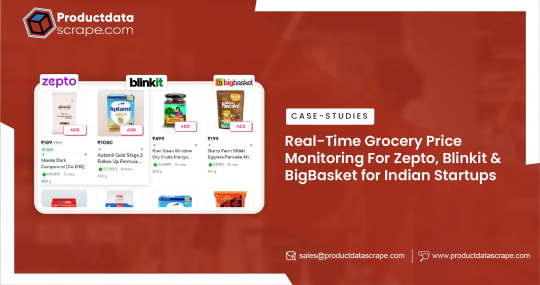
Introduction
India’s quick commerce boom has transformed how millions shop for groceries. To keep up with changing prices, offers, and hyperlocal stock availability, Indian startups are embracing Real-Time Grocery Price Monitoring For Zepto, Blinkit & BigBasket. Product Data Scrape helps these brands build competitive, real-time insights into grocery price shifts, discounts, and competitor tactics. By combining Scrape Real-Time Price Data from Zepto, Blinkit & BigBasket with robust tracking tools, startups now respond instantly to market moves and demand spikes. In this case study, discover how real-time price monitoring has powered smarter pricing, increased sales, and improved customer loyalty for India’s fastest-growing quick commerce brands.
The Client
An emerging grocery aggregator startup approached Product Data Scrape with one clear goal: outperform larger players by using reliable, granular price intelligence across India’s top grocery delivery apps. This client needed Real-Time Grocery Price Monitoring For Zepto, Blinkit & BigBasket to spot price drops, match competitor discounts, and adjust their own offers dynamically. With fierce local competition and daily pricing changes, it was no longer enough to rely on manual checks or outdated spreadsheets. The client also wanted to scale insights across multiple cities and store formats, covering essentials, fresh produce, and Gourmet Food Data. The need for a trusted partner who could deliver Real-Time Data Monitoring for Grocery Prices & Discounts led them to Product Data Scrape’s proven expertise. The client’s vision was clear: get real-time data or get left behind.
Key Challenges
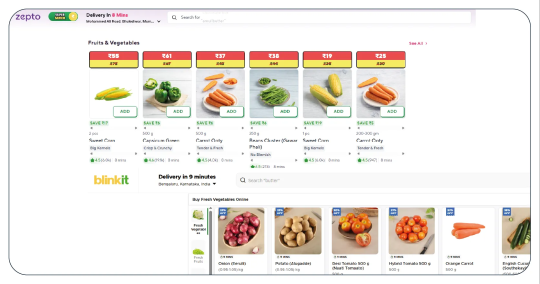
The client faced several challenges typical for India’s quick commerce and grocery tech startups. First, manual price checks on Zepto, Blinkit, and BigBasket were time-consuming and error-prone, missing daily promotions and location-specific discounts. Second, without a system to Scrape Real-Time Price Data from Zepto, Blinkit & BigBasket, they couldn’t confidently match or beat competitor offers, which led to lost customers. Third, the team struggled to handle huge volumes of SKU-level data with variations across cities, PIN codes, and product categories. They needed Real-Time Grocery Price Tracking from Zepto, Blinkit & BigBasket to feed their pricing engines and marketing tools automatically. Additionally, they lacked robust tools for Quick Commerce Grocery & FMCG Data Scraping, which meant missing insights on emerging neighborhood-level demand. They also required clean integrations with Real-Time Indian Grocery Price Scraping APIs , so their tech stack could automatically update pricing dashboards daily. Without dependable Grocery Price Monitoring Scraper For Zepto, Blinkit & BigBasket, their strategy was reactive instead of proactive. Staying competitive demanded a scalable solution to Extract Blinkit Grocery & Gourmet Food Data , Extract Bigbasket Product Data , and launch smarter promotions instantly.
Key Solutions
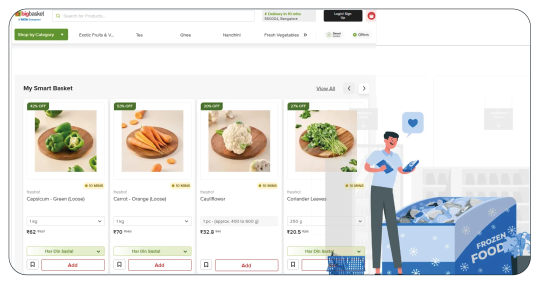
Product Data Scrape built a robust solution covering every pain point. We deployed dedicated crawlers to Scrape Real-Time Price Data from Zepto, Blinkit & BigBasket with 99% accuracy. The client gained city-level price feeds that updated hourly, fueling their dynamic pricing engine with precise SKU details and store-specific offers. Our team customized Zepto Grocery Data Scraping modules to capture neighborhood differences for quick commerce. Combined with Web Scraping Grocery Price Data, they could compare pricing trends, track discounts, and identify competitors’ loss leaders. To scale, we integrated Real-Time Indian Grocery Price Scraping APIs into the client’s dashboards, giving instant visibility into price gaps and fresh offers.
Product Data Scrape also activated Grocery & Supermarket Data Scraping Services for broader market mapping, including insights from smaller grocery stores and specialty listings. The client used our Grocery Data Scraping Services to enhance supply chain forecasting and inventory planning with a high-quality Grocery Store Dataset. Our tools helped them Scrape Grocery & Gourmet Food Data to spot premium product trends, boosting margins with curated assortments. Together, this complete solution turned chaotic market signals into actionable pricing strategies. Today, the client uses Product Data Scrape for continuous Grocery Price Monitoring Scraper For Zepto, Blinkit & BigBasket, plus robust Quick Commerce Grocery & FMCG Data Scraping to stay ahead in India’s competitive grocery space.
Client’s Testimonial
"Product Data Scrape transformed how we compete. Their Real-Time Grocery Price Monitoring For Zepto, Blinkit & BigBasket helps us adjust prices daily, match discounts, and win more loyal customers. Their data scraping quality and support are unmatched."
— Head of Growth, Leading Indian Quick Commerce Startup
Conclusion
Real-time grocery price tracking is no longer optional for India’s quick commerce brands — it’s mission-critical. This case study proves that Real-Time Grocery Price Monitoring For Zepto, Blinkit & BigBasket drives competitive advantage, sharper pricing, and smarter promotions. Product Data Scrape remains the trusted partner for startups that need powerful Grocery Price Monitoring Scraper For Zepto, Blinkit & BigBasket and ready-to-use insights that fuel growth. Get started with Product Data Scrape today and unlock your edge in India’s grocery market!
Unlock More Info>>>https://www.productdatascrape.com/real-time-grocery-price-monitoring-zepto-blinkit-bigbasket.php
#RealTimeGroceryPriceMonitoringForZeptoBlinkitAndBigBasket#ScrapeRealTimePriceDataFromZeptoBlinkitAndBigBasket#RealTimeDataMonitoringForGroceryPricesAndDiscounts#RealTimeGroceryPriceTrackingFromZeptoBlinkitAndBigBasket#RealTimeIndianGroceryPriceScrapingAPIs#QuickCommerceGroceryAndFMCGDataScraping#WebScrapingGroceryPriceData
0 notes
Text
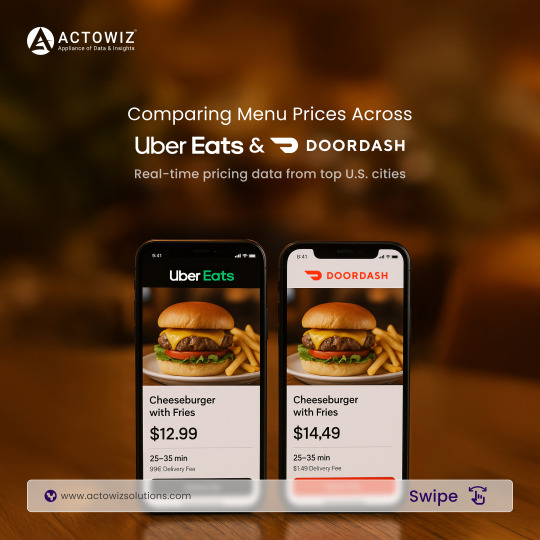
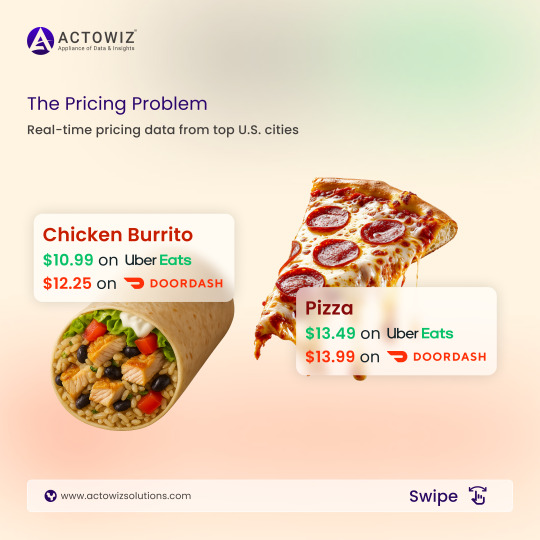
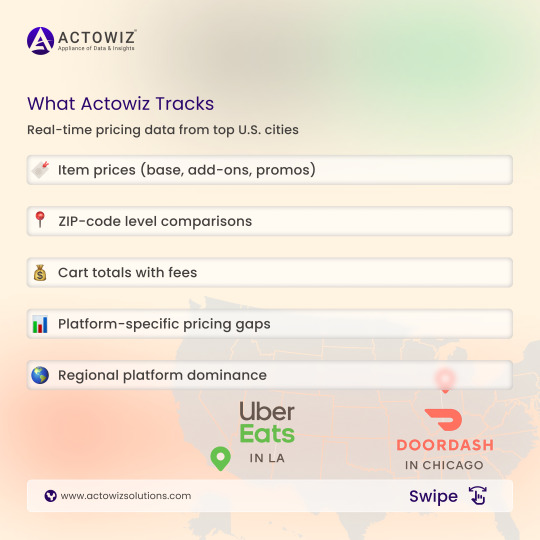
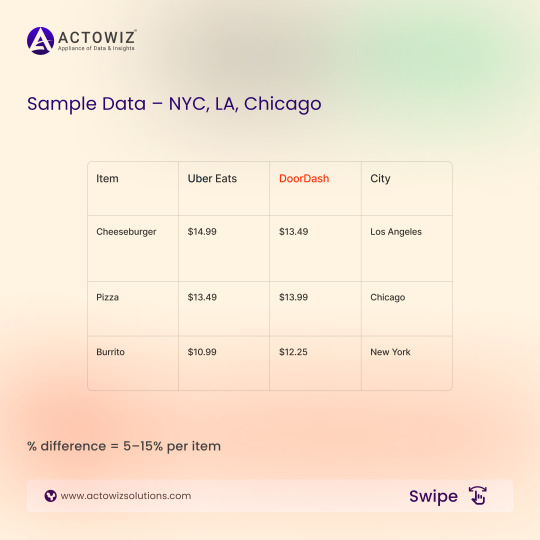
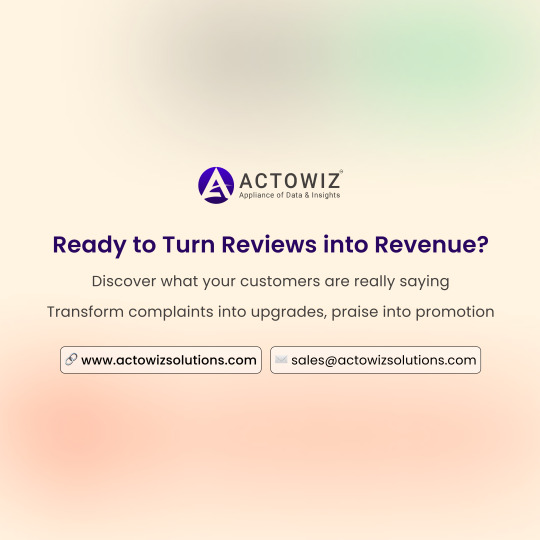
🍔 Are You Overpaying for the Same Meal on Different Apps?
At Actowiz Solutions, we analyzed real-time food delivery prices across #UberEats and #DoorDash in major #US cities-and the results are eye-opening.
📊 Here’s What We Tracked Across NYC, LA & Chicago:
✅ Menu item pricing (base price + add-ons)
✅ ZIP-code level comparisons
✅ Platform-specific fee structures
✅ Cart total breakdowns
✅ Delivery time estimates
✅ Regional dominance by platform
🔍 Want to know why your cheeseburger costs $2 more on one app than another? Or how promotions change by #ZIPCode? These subtle pricing differences (5–15%) can drive massive impact for:
🔹 QSR chains & restaurant aggregators
🔹 Competitive benchmarking teams
🔹 Consumer behavior researchers
🔹 D2C food brands
💼 Whether you're in pricing strategy, market intelligence, or platform analytics, Actowiz’s #FoodDeliveryPriceScraping can give you unmatched visibility into how #FoodPlatforms operate across geographies.
📩 Let’s discuss how custom data scraping can uncover your edge.
🔗 Learn more: https://www.actowizsolutions.com/ubereats-doordash-menu-price-comparison.php
📧 Contact: [email protected]
0 notes
Text
Automating Restaurant Menu Data Extraction Using Web Scraping APIs
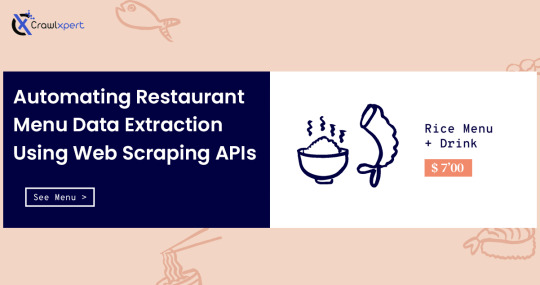
Introduction
The food and restaurant business sector is going very heavily digital with millions of restaurant menus being made available through online platforms. Companies that are into food delivery, restaurant aggregation, and market research require menu data on a real-time basis for competition analysis, pricing strategies, and enhancement of customer experience. Manually collecting and updating this information is time-consuming and a laborious endeavor. This is where web scraping APIs come into play with the automated collection of such information to scrape restaurant menu data efficiently and accurately.
This guide discusses the importance of extracting restaurant menu data, how web scraping works for this use case, some challenges to expect, the best practices in dealing with such issues, and the future direction of menu data automation.
Why Export Restaurant Menu Data?
1. Food Delivery Service
Most online food delivery services, like Uber Eats, DoorDash, and Grubhub, need real-time menu updates for accurate pricing or availability. With the extraction of restaurant menu data, at least those online platforms are kept updated and discrepancies avoidable.
2. Competitive Pricing Strategy
Restaurants and food chains make use of web scraping restaurant menu data to determine their competitors' price positions. By tracking rival menus, they will know how they should price their products to remain competitive in the marketplace.
3. Nutritional and Dietary Insights
Health and wellness platforms utilize menu data for dietary recommendations to customers. By scraping restaurant menu data, these platforms can classify foods according to calorie levels, ingredients, and allergens.
4. Market Research and Trend Analysis
This is the group of data analysts and research firms collecting restaurant menu data to analyze consumer behavior about cuisines and track price variations with time.
5. Personalized Food Recommendations
Machine learning and artificial intelligence now provide food apps with the means to recommend meals according to user preferences. With restaurant menu data web scraping, food apps can access updated menus and thus afford personalized suggestions on food.
How Web Scraping APIs Automate Restaurant Menu Data Extraction
1. Identifying Target Websites
The first step is selecting restaurant platforms such as:
Food delivery aggregators (Uber Eats, DoorDash, Grubhub)
Restaurant chains' official websites (McDonald's, Subway, Starbucks)
Review sites (Yelp, TripAdvisor)
Local restaurant directories
2. Sending HTTP Requests
Scraping APIs send HTTP requests to restaurant websites to retrieve HTML content containing menu information.
3. Parsing HTML Data
The extracted HTML is parsed using tools like BeautifulSoup, Scrapy, or Selenium to locate menu items, prices, descriptions, and images.
4. Structuring and Storing Data
Once extracted, the data is formatted into JSON, CSV, or databases for easy integration with applications.
5. Automating Data Updates
APIs can be scheduled to run periodically, ensuring restaurant menus are always up to date.
Data Fields Extracted from Restaurant Menus
1. Restaurant Information
Restaurant Name
Address & Location
Contact Details
Cuisine Type
Ratings & Reviews
2. Menu Items
Dish Name
Description
Category (e.g., Appetizers, Main Course, Desserts)
Ingredients
Nutritional Information
3. Pricing and Discounts
Item Price
Combo Offers
Special Discounts
Delivery Fees
4. Availability & Ordering Information
Available Timings
In-Stock/Out-of-Stock Status
Delivery & Pickup Options
Challenges in Restaurant Menu Data Extraction
1. Frequent Menu Updates
Restaurants frequently update their menus, making it challenging to maintain up-to-date data.
2. Anti-Scraping Mechanisms
Many restaurant websites implement CAPTCHAs, bot detection, and IP blocking to prevent automated data extraction.
3. Dynamic Content Loading
Most restaurant platforms use JavaScript to load menu data dynamically, requiring headless browsers like Selenium or Puppeteer for scraping.
4. Data Standardization Issues
Different restaurants structure their menu data in various formats, making it difficult to standardize extracted information.
5. Legal and Ethical Considerations
Extracting restaurant menu data must comply with legal guidelines, including robots.txt policies and data privacy laws.
Best Practices for Scraping Restaurant Menu Data
1. Use API-Based Scraping
Leveraging dedicated web scraping APIs ensures more efficient and reliable data extraction without worrying about website restrictions.
2. Rotate IP Addresses & Use Proxies
Avoid IP bans by using rotating proxies or VPNs to simulate different users accessing the website.
3. Implement Headless Browsers
For JavaScript-heavy pages, headless browsers like Puppeteer or Selenium can load and extract dynamic content.
4. Use AI for Data Cleaning
Machine learning algorithms help clean and normalize menu data, making it structured and consistent across different sources.
5. Schedule Automated Scraping Jobs
To maintain up-to-date menu data, set up scheduled scraping jobs that run daily or weekly.
Popular Web Scraping APIs for Restaurant Menu Data Extraction
1. Scrapy Cloud API
A powerful cloud-based API that allows automated menu data scraping at scale.
2. Apify Restaurant Scraper
Apify provides pre-built restaurant scrapers that can extract menu details from multiple platforms.
3. Octoparse
A no-code scraping tool with API integration, ideal for businesses that require frequent menu updates.
4. ParseHub
A flexible API that extracts structured restaurant menu data with minimal coding requirements.
5. CrawlXpert API
A robust and scalable solution tailored for web scraping restaurant menu data, offering real-time data extraction with advanced anti-blocking mechanisms.
Future of Restaurant Menu Data Extraction
1. AI-Powered Menu Scraping
Artificial intelligence will improve data extraction accuracy, enabling automatic menu updates without manual intervention.
2. Real-Time Menu Synchronization
Restaurants will integrate web scraping APIs to sync menu data instantly across platforms.
3. Predictive Pricing Analysis
Machine learning models will analyze scraped menu data to predict price fluctuations and customer demand trends.
4. Enhanced Personalization in Food Apps
By leveraging scraped menu data, food delivery apps will provide more personalized recommendations based on user preferences.
5. Blockchain for Menu Authentication
Blockchain technology may be used to verify menu authenticity, preventing fraudulent modifications in restaurant listings.
Conclusion
Automating the extraction of restaurant menus from the web through scraping APIs has changed the food industry by offering real-time prices, recommendations for food based on liking, and analysis of competitors. With advances in technology, more AI-driven scraping solutions will further improve the accuracy and speed of data collection.
Know More : https://www.crawlxpert.com/blog/restaurant-menu-data-extraction-using-web-scraping-apis
#RestaurantMenuDataExtraction#ScrapingRestaurantMenuData#ExtractRestaurantMenus#ScrapeRestaurantMenuData
0 notes
Text
🍟 Why QSRs Are Turning to Real-Time Delivery App Data for Smarter Pricing
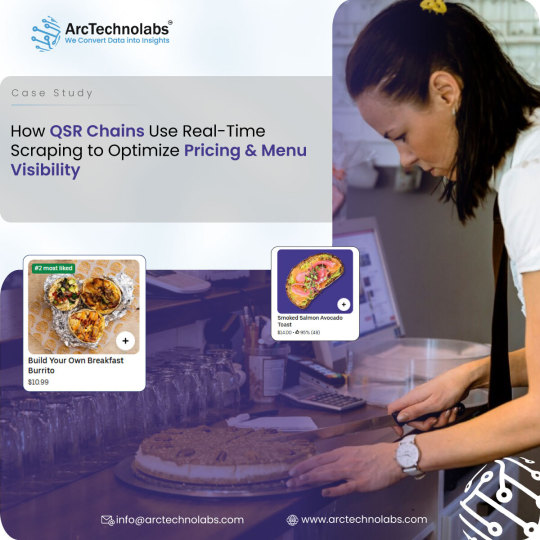
In the age of digital food delivery, pricing is no longer just about cost—it’s about context.
ArcTechnoLabs' latest analysis explores how scraping real-time data from delivery platforms (like Swiggy, Zomato, Uber Eats, etc.) helps quick-service restaurants (QSRs) implement dynamic pricing strategies to:
✅ Respond instantly to fluctuating delivery fees and competitor pricing
✅ Adjust menu prices based on demand, time slots, or region
✅ Improve operational margins without compromising customer satisfaction
✅ Track promo trends and benchmark performance across cities or delivery platforms
📊 “Brands using real-time QSR pricing insights reported up to 20% profit growth and 30% better alignment with local delivery market dynamics.”
💡 Whether you manage pricing, operations, growth, or analytics in the F&B, cloud kitchen, or delivery aggregator space, this deep dive is packed with strategic value.
#advancewebscrapingservices#webscrapingapiservices#mobileappscrapingservices#arctechnolabs#webscrapingservices#technology#india
0 notes
Text
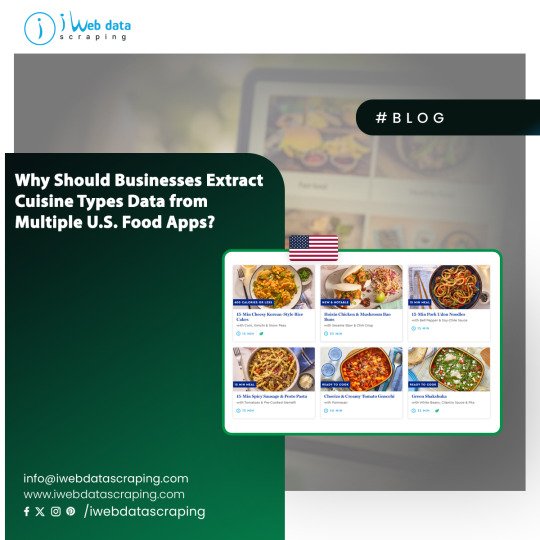
🍱 Why Should Businesses Extract Cuisine Type Data from Multiple U.S. Food Apps?
From tacos to Thai, tracking cuisine trends across food delivery platforms can unlock powerful market intelligence for restaurants, aggregators, cloud kitchens, and #FMCGBrands.
At iWeb Data Scraping, we extract structured cuisine data from top #USFoodApps-like #UberEats, #DoorDash, #Grubhub, and Postmates—to help businesses:
📊 What You Can Uncover:
✅ Most-ordered cuisine types by region & season
✅ Category trends: fast casual, vegan, ethnic, premium
✅ Consumer behavior by time of day & location
✅ Cuisine growth rates on each platform
✅ Market gaps for emerging or underrepresented cuisines
💡 Why It Matters:
• Optimize location-specific menus
• Launch high-demand food brands faster
• Power marketing with real-time taste preferences
• Identify cuisine demand shifts before your competitors do
🔗 Get smarter with cuisine data:
https://www.iwebdatascraping.com/extract-cuisine-types-data-from-us-food-apps.php
0 notes